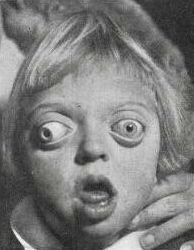
Muscular dystrophies (MD) are a genetically and clinically heterogeneous group of rare muscle disorders that cause progressive weakness and breakdown of skeletal muscles over time. The disorders differ as to which muscles are primarily affected, the degree of weakness, how fast they worsen, and when symptoms begin. Some types are also associated with problems in other organs.
Myotonia is a symptom of a small handful of certain neuromuscular disorders characterized by delayed relaxation of the skeletal muscles after voluntary contraction or electrical stimulation.
In genetics, anticipation is a phenomenon whereby as a genetic disorder is passed on to the next generation, the symptoms of the genetic disorder become apparent at an earlier age with each generation. In most cases, an increase in the severity of symptoms is also noted. Anticipation is common in trinucleotide repeat disorders, such as Huntington's disease and myotonic dystrophy, where a dynamic mutation in DNA occurs. All of these diseases have neurological symptoms. Prior to the understanding of the genetic mechanism for anticipation, it was debated whether anticipation was a true biological phenomenon or whether the earlier age of diagnosis was related to heightened awareness of disease symptoms within a family.
Sean Reed Barker is a former Major League Baseball outfielder. He made his major league debut June 6, 2007, with a plate appearance against Chad Qualls of the Houston Astros. He was hit by the very first pitch of his major league career and then stranded on second base after advancing on a fielders choice.
Dystrophy is the degeneration of tissue, due to disease or malnutrition, most likely due to heredity.

Myotonic dystrophy is a type of muscular dystrophy, a group of long-term genetic disorders that impair muscle function. Symptoms include gradually worsening muscle loss and weakness. Muscles often contract and are unable to relax. Other symptoms may include cataracts, intellectual disability and heart conduction problems. In men, there may be early balding and an inability to have children.

Band keratopathy is a corneal disease derived from the appearance of calcium on the central cornea. This is an example of metastatic calcification, which by definition, occurs in the presence of hypercalcemia.
The Muscular Dystrophy Community Assistance Research and Education Amendments of 2001 amended the Public Health Service Act to provide for research with respect to various forms of muscular dystrophy, including Duchenne, Becker, limb girdle, congenital, facioscapulohumeral, myotonic, oculopharyngeal, distal, and Emery–Dreifuss muscular dystrophies.

Myotonin-protein kinase (MT-PK) also known as myotonic dystrophy protein kinase (MDPK) or dystrophia myotonica protein kinase (DMPK) is an enzyme that in humans is encoded by the DMPK gene.

CUG triplet repeat, RNA binding protein 1, also known as CUGBP1, is a protein which in humans is encoded by the CUGBP1 gene.

Serine/threonine-protein kinase MRCK alpha is an enzyme that in humans is encoded by the CDC42BPA gene.

Muscleblind Like Splicing Regulator 1 (MBNL1) is an RNA splicing protein that in humans is encoded by the MBNL1 gene. It has a well characterized role in Myotonic dystrophy where impaired splicing disrupts muscle development and function. In addition to regulating mRNA maturation of hundreds of genes MBNL1 autoregulate alternative splicing of the MBNL1 pre-mRNA transcript. The founding member of the human MBNL family of proteins was the Drosophila Muscleblind protein.

Cellular nucleic acid-binding protein is a protein that in humans is encoded by the CNBP gene.

Homeobox protein SIX5 is a protein that in humans is encoded by the SIX5 gene.

Dystrophia myotonica WD repeat-containing protein is a protein that in humans is encoded by the DMWD gene.

In medical contexts, a facies is a distinctive facial expression or appearance associated with a specific medical condition. The term comes from the Latin for "face". As a fifth declension noun, facies can be both singular and plural.
Gowers' sign is a medical sign that indicates weakness of the proximal muscles, namely those of the lower limb. The sign describes a patient that has to use their hands and arms to "walk" up their own body from a squatting position due to lack of hip and thigh muscle strength.
RNA-dominant diseases are characterized by deleterious mutations that typically result in degenerative disorders affecting various neurological, cardiovascular, and muscular functions. Studies have found that they arise from repetitive non-coding RNA sequences, also known as toxic RNA, which inhibit RNA-binding proteins leading to pathogenic effects. The most studied RNA-dominant diseases include, but are not limited to, myotonic dystrophy and fragile X-associated tremor/ataxia syndrome (FXTAS).







